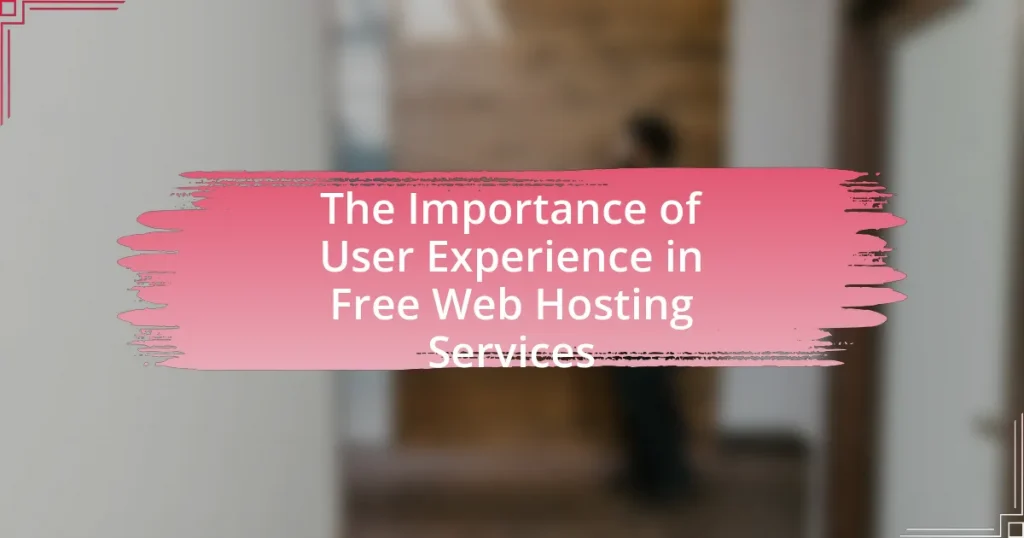The article focuses on comparing free hosting options with paid hosting services, highlighting key differences in performance, reliability, and support. It outlines how free hosting typically offers limited resources, slower load times, and frequent downtimes, while paid hosting provides enhanced features such as higher uptime guarantees, dedicated resources, and better customer support. The discussion includes specific performance metrics to consider, the limitations of free hosting, and the advantages of paid options, emphasizing the long-term implications for website growth and SEO performance. Additionally, it addresses best practices for transitioning from free to paid hosting and strategies for optimizing performance in both hosting types.

What are the key differences between free and paid hosting options?
Free hosting options typically offer limited resources, such as bandwidth and storage, while paid hosting options provide more robust features, including higher performance, better security, and customer support. Free hosting often includes advertisements and lacks a custom domain, whereas paid hosting allows for a personalized domain name and generally offers enhanced uptime and reliability. For instance, paid hosting services can guarantee 99.9% uptime compared to the often lower reliability of free services, which may experience frequent downtimes. Additionally, paid hosting usually includes advanced features like SSL certificates and backups, which are rarely available in free hosting plans.
How do performance metrics vary between free and paid hosting?
Performance metrics significantly differ between free and paid hosting, with paid hosting generally offering superior speed, uptime, and customer support. Free hosting often suffers from slower load times due to shared resources among numerous users, while paid hosting typically provides dedicated resources, resulting in faster performance. Additionally, paid hosting services boast higher uptime percentages, often exceeding 99.9%, compared to free hosting, which may experience frequent downtimes and limited reliability. Furthermore, paid hosting usually includes better technical support, ensuring quicker resolution of issues, which is often lacking in free hosting options.
What specific performance indicators should be considered?
Specific performance indicators to consider when comparing free hosting with paid options include uptime, load time, bandwidth, storage capacity, customer support response time, and scalability. Uptime measures the percentage of time the hosting service is operational, with a benchmark of 99.9% being standard for reliable services. Load time, ideally under three seconds, impacts user experience and SEO rankings. Bandwidth indicates the amount of data transfer allowed, while storage capacity affects the volume of content hosted. Customer support response time is crucial for resolving issues quickly, and scalability ensures the service can grow with increasing demands. These indicators provide a comprehensive view of hosting performance, enabling informed decisions.
How do uptime and reliability compare in free versus paid hosting?
Paid hosting generally offers significantly better uptime and reliability compared to free hosting. Paid hosting services typically guarantee uptime percentages of 99.9% or higher, backed by service level agreements (SLAs), while free hosting often experiences frequent downtimes and lacks formal uptime guarantees. For instance, a study by HostingFacts in 2021 indicated that free hosting services had an average uptime of around 90%, leading to potential disruptions for users. In contrast, reputable paid hosting providers invest in robust infrastructure and support, ensuring consistent performance and reliability for their customers.
What are the limitations of free hosting services?
Free hosting services have several limitations, including restricted bandwidth, limited storage space, and lack of customer support. These constraints can hinder website performance and user experience, as many free hosting providers impose strict data transfer limits, which can lead to slow loading times or downtime during peak traffic. Additionally, free hosting often offers minimal storage capacity, making it challenging for users to host larger websites or applications. Furthermore, the absence of reliable customer support can leave users without assistance during critical issues, impacting their ability to resolve problems quickly.
How do resource allocations differ in free hosting plans?
Resource allocations in free hosting plans typically offer limited bandwidth, storage, and processing power compared to paid options. Free hosting plans often restrict bandwidth to a few gigabytes per month, provide minimal storage (often under 1 GB), and may impose CPU usage limits, which can lead to slower performance and downtime during peak traffic. In contrast, paid hosting plans generally provide significantly higher resource allocations, including unlimited bandwidth, larger storage capacities (often several terabytes), and enhanced processing capabilities, ensuring better performance and reliability for users.
What impact do ads and branding have on free hosting user experience?
Ads and branding significantly detract from the user experience in free hosting services. Users often encounter intrusive advertisements that disrupt website navigation and content consumption, leading to frustration and decreased engagement. A study by the Nielsen Norman Group found that excessive ads can reduce user satisfaction by up to 30%, as they distract from the primary content and create a cluttered interface. Additionally, branding elements associated with free hosting services can diminish perceived professionalism, as users may associate these ads with lower quality or reliability. This perception can negatively impact user trust and retention, ultimately affecting the overall effectiveness of the free hosting service.
What advantages do paid hosting options provide?
Paid hosting options provide enhanced performance, reliability, and support compared to free hosting services. These advantages include faster loading times due to dedicated resources, higher uptime guarantees often exceeding 99.9%, and access to customer support that is typically more responsive and knowledgeable. For instance, a study by HostingFacts indicates that paid hosting services generally offer better server performance, which can lead to improved user experience and SEO rankings. Additionally, paid hosting often includes features such as custom domain names, increased storage, and advanced security measures, which are crucial for businesses and professional websites.
How does customer support differ between free and paid hosting?
Customer support significantly differs between free and paid hosting, primarily in availability and quality. Free hosting services often provide limited or no customer support, relying on community forums or self-help resources, which can lead to delayed resolutions. In contrast, paid hosting typically offers 24/7 customer support through multiple channels such as live chat, phone, and email, ensuring quicker and more effective assistance. This difference is evident as many paid hosting providers, like Bluehost and SiteGround, guarantee response times and dedicated support teams, enhancing user experience and satisfaction.
What scalability options are available with paid hosting services?
Paid hosting services offer several scalability options, including vertical scaling, horizontal scaling, and cloud-based scaling. Vertical scaling allows users to increase resources such as CPU, RAM, and storage on a single server, which is often straightforward but has limits based on the server’s capacity. Horizontal scaling involves adding more servers to distribute the load, enhancing performance and reliability, particularly for high-traffic websites. Cloud-based scaling, commonly provided by services like AWS or Google Cloud, enables dynamic resource allocation based on real-time demand, allowing businesses to efficiently manage traffic spikes without over-provisioning resources. These options ensure that paid hosting services can accommodate growth and changing needs effectively.

How do user needs influence the choice between free and paid hosting?
User needs significantly influence the choice between free and paid hosting by determining the level of performance, reliability, and support required. Users seeking basic functionality and minimal traffic may opt for free hosting, which typically offers limited resources and features. In contrast, users with higher demands, such as e-commerce sites or those requiring enhanced security and uptime, are more likely to choose paid hosting, which provides better performance, customer support, and scalability. Research indicates that 70% of businesses report improved website performance and customer satisfaction after switching to paid hosting options, highlighting the impact of user needs on hosting decisions.
What types of websites benefit from free hosting?
Websites that benefit from free hosting typically include personal blogs, small portfolios, hobby sites, and educational projects. These types of websites often have low traffic demands and minimal resource requirements, making free hosting a suitable option. For instance, personal blogs can effectively utilize platforms like WordPress.com or Blogger, which offer free hosting services, allowing users to share content without incurring costs. Additionally, small portfolios and hobby sites often do not require advanced features or high uptime guarantees, making free hosting an economical choice for individuals looking to showcase their work or interests.
How does the purpose of a website affect hosting choice?
The purpose of a website significantly influences the choice of hosting by determining the required resources, performance needs, and scalability options. For instance, an e-commerce site necessitates robust security features, high uptime, and fast loading speeds, which are typically offered by paid hosting services. In contrast, a personal blog may function adequately on free hosting platforms, which often have limited resources and support. According to a study by HostingAdvice, 70% of businesses reported that website performance directly impacts user experience and conversion rates, underscoring the importance of selecting a hosting option aligned with the website’s purpose.
What are the risks associated with using free hosting for business websites?
Using free hosting for business websites poses several risks, including limited resources, lack of customer support, and security vulnerabilities. Limited resources can lead to slow website performance and downtime, which negatively impacts user experience and search engine rankings. The absence of customer support means that businesses may struggle to resolve technical issues promptly, potentially leading to extended outages. Additionally, free hosting services often lack robust security measures, making websites more susceptible to hacking and data breaches, which can compromise sensitive customer information and damage a business’s reputation.
What factors should be considered when selecting a paid hosting provider?
When selecting a paid hosting provider, key factors include reliability, performance, customer support, pricing, and scalability. Reliability is crucial as it ensures minimal downtime; for instance, a provider with a 99.9% uptime guarantee is preferable. Performance relates to speed and server response times, which can significantly affect user experience; studies show that a one-second delay can reduce conversions by 7%. Customer support should be accessible and responsive, ideally offering 24/7 assistance through multiple channels. Pricing must align with the budget while considering the features offered, such as storage and bandwidth limits. Lastly, scalability is important for future growth, allowing easy upgrades as website traffic increases.
How do pricing structures vary among paid hosting services?
Pricing structures among paid hosting services vary primarily based on factors such as resource allocation, service level, and additional features. For instance, shared hosting plans typically offer lower prices due to resource sharing among multiple users, while dedicated hosting plans command higher fees because they provide exclusive resources to a single user. Additionally, pricing can differ based on the level of customer support, with managed hosting services often costing more due to the inclusion of technical assistance and maintenance. According to a 2023 survey by HostingAdvice, the average monthly cost for shared hosting is around $3 to $10, while VPS hosting ranges from $20 to $100, and dedicated hosting can exceed $100 per month. This data illustrates the significant price differences based on the type of hosting service and the resources provided.
What features should be prioritized in a paid hosting plan?
A paid hosting plan should prioritize features such as reliability, speed, security, and customer support. Reliability is crucial, as it ensures minimal downtime; for instance, a study by HostingFacts indicates that top-tier paid hosts offer uptime guarantees of 99.9% or higher. Speed is essential for user experience and SEO, with research showing that a one-second delay in page load time can lead to a 7% reduction in conversions. Security features, including SSL certificates and regular backups, protect against data breaches and loss, which are vital for maintaining trust and compliance. Lastly, responsive customer support is important, as 24/7 assistance can resolve issues quickly, enhancing overall service satisfaction.

What are the long-term implications of choosing free versus paid hosting?
Choosing free hosting often leads to limitations in performance, reliability, and scalability compared to paid hosting. Free hosting typically comes with restricted bandwidth, limited storage, and fewer features, which can hinder website growth and user experience over time. In contrast, paid hosting offers dedicated resources, enhanced security, and customer support, which are crucial for maintaining a professional online presence.
For instance, a study by HostingAdvice found that 70% of websites using free hosting experience downtime, while paid hosting services boast uptime rates of 99.9%. Additionally, free hosting may include ads and lack a custom domain, which can negatively impact brand credibility. Therefore, the long-term implications of choosing free hosting often result in increased costs and challenges as businesses grow, while paid hosting provides a more sustainable and scalable solution.
How can free hosting impact website growth and performance over time?
Free hosting can significantly hinder website growth and performance over time due to limitations in resources, reliability, and support. Websites on free hosting often experience slower loading times, which can lead to higher bounce rates; studies show that a one-second delay in page load time can reduce conversions by 7%. Additionally, free hosting services typically impose bandwidth and storage restrictions, limiting the ability to scale as traffic increases. Security features are often minimal, making sites more vulnerable to attacks, which can further degrade performance and user trust. Furthermore, the lack of customer support can result in prolonged downtime, negatively impacting user experience and search engine rankings. Overall, these factors collectively impede the long-term growth and effectiveness of a website hosted for free.
What are the potential costs associated with switching from free to paid hosting?
Switching from free to paid hosting can incur several potential costs, including monthly or annual subscription fees, domain registration fees, and potential migration costs. Paid hosting plans typically range from $3 to $30 per month, depending on the features and resources provided. Additionally, domain registration can cost around $10 to $20 per year. If a website requires professional assistance for migration, this service can add another $50 to $200. These costs reflect the transition from limited resources and support in free hosting to enhanced performance, security, and customer service in paid hosting options.
How does SEO performance differ between free and paid hosting options?
SEO performance typically differs significantly between free and paid hosting options, with paid hosting generally offering better speed, uptime, and support, which are critical factors for search engine rankings. Free hosting often suffers from slower load times and frequent downtimes due to shared resources, negatively impacting user experience and SEO metrics. According to a study by Google, page speed is a ranking factor, and sites that load slowly can see a drop in rankings. Additionally, free hosting services may impose restrictions on bandwidth and storage, leading to potential site outages or slow performance during high traffic, further harming SEO. In contrast, paid hosting usually provides dedicated resources, enhanced security, and customer support, all of which contribute to improved SEO outcomes.
What best practices should be followed when transitioning from free to paid hosting?
When transitioning from free to paid hosting, it is essential to conduct a thorough assessment of your website’s needs and select a hosting plan that aligns with those requirements. This involves evaluating factors such as bandwidth, storage, and customer support, which are often limited in free hosting services. For instance, a study by HostingAdvice found that 70% of users experienced performance issues with free hosting, highlighting the importance of investing in a reliable paid option to ensure better uptime and speed. Additionally, migrating your website data securely and testing the new environment before fully switching over can prevent downtime and data loss. Implementing these best practices will facilitate a smoother transition and enhance your website’s performance.
How can users ensure a smooth migration process?
Users can ensure a smooth migration process by thoroughly planning and executing each step of the transition. This includes creating a detailed migration plan that outlines timelines, resources, and responsibilities, which helps to minimize disruptions. Additionally, users should back up all data before initiating the migration to prevent data loss, as studies show that 30% of data loss incidents occur during migration processes. Testing the new environment before fully switching over is also crucial, as it allows users to identify and resolve potential issues in advance. By following these steps, users can significantly reduce the risks associated with migration and enhance overall performance during the transition.
What common pitfalls should be avoided during the transition?
Common pitfalls to avoid during the transition from free hosting to paid options include underestimating the importance of data migration, neglecting to assess performance requirements, and failing to communicate changes to stakeholders. Data migration issues can lead to loss of information or downtime if not properly managed, as evidenced by a study from the University of California, which found that 30% of organizations experienced data loss during transitions. Assessing performance requirements is crucial; many users choose plans that do not meet their needs, resulting in slow load times or downtime. Lastly, clear communication with stakeholders ensures that all parties are aware of the changes and can adapt accordingly, reducing resistance and confusion during the transition process.
What are the most effective strategies for optimizing performance in both hosting types?
The most effective strategies for optimizing performance in both free and paid hosting types include utilizing content delivery networks (CDNs), optimizing website code and images, and implementing caching mechanisms. CDNs enhance performance by distributing content across multiple servers globally, reducing latency and load times. Optimizing website code and images minimizes file sizes and improves loading speed, which is crucial for user experience and search engine rankings. Caching mechanisms store frequently accessed data, reducing server load and speeding up response times. These strategies are supported by studies indicating that optimized websites can achieve load times under three seconds, significantly improving user engagement and retention.















